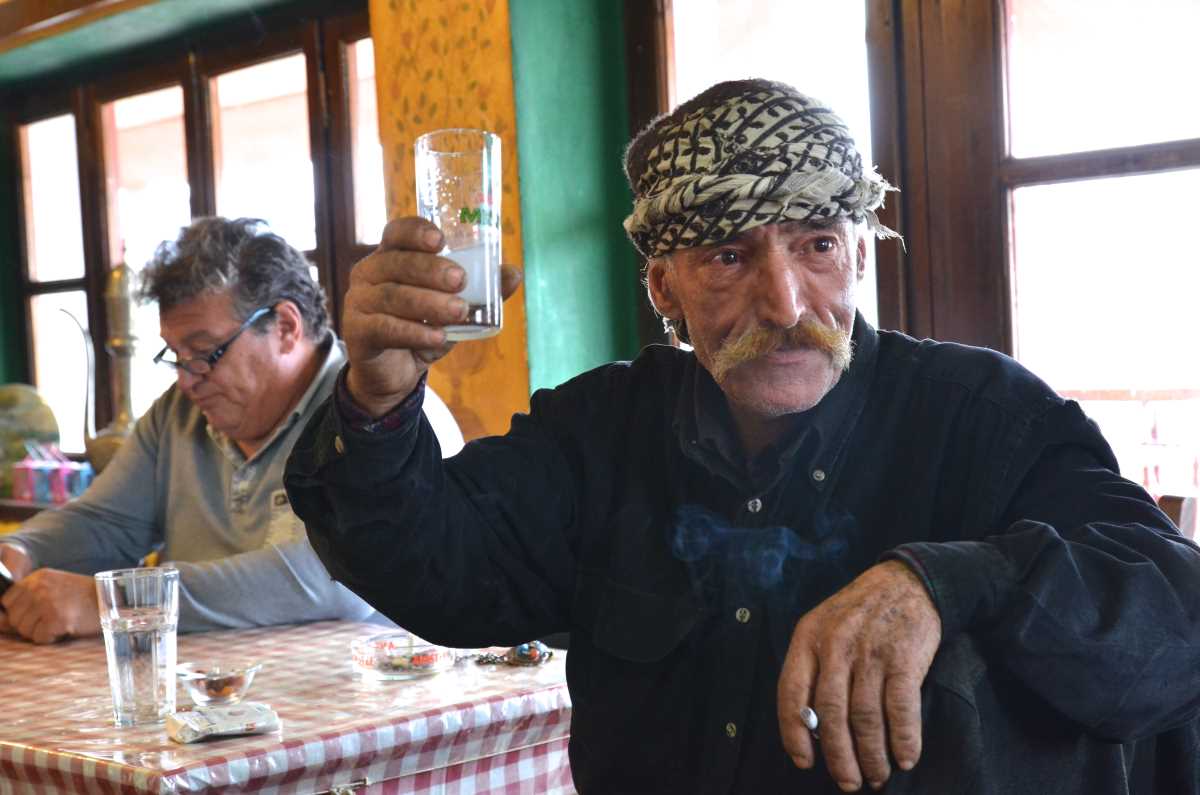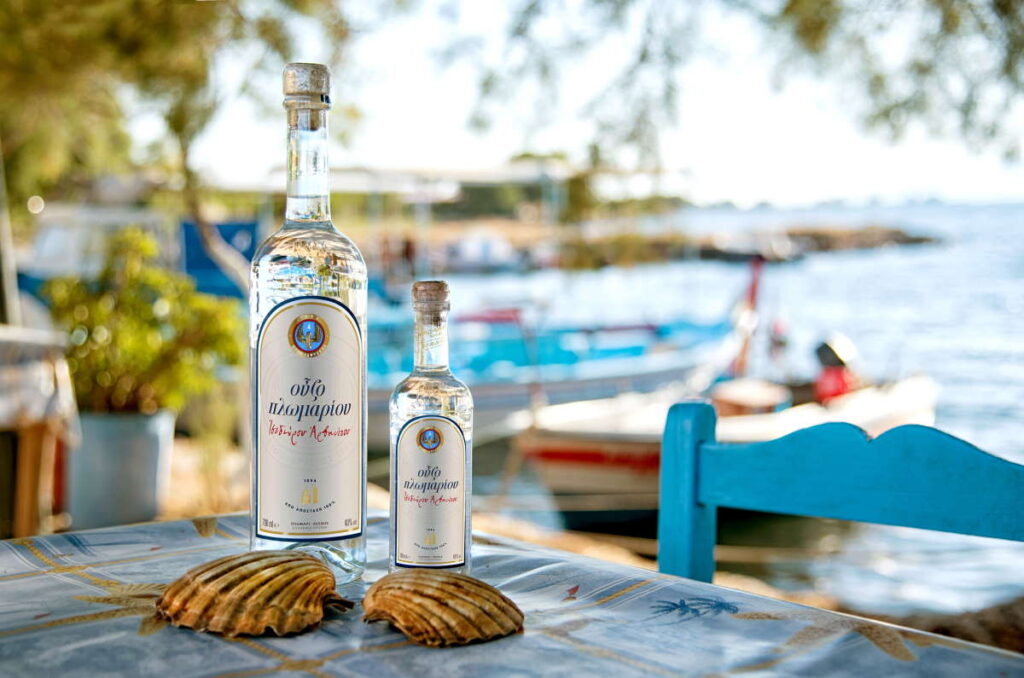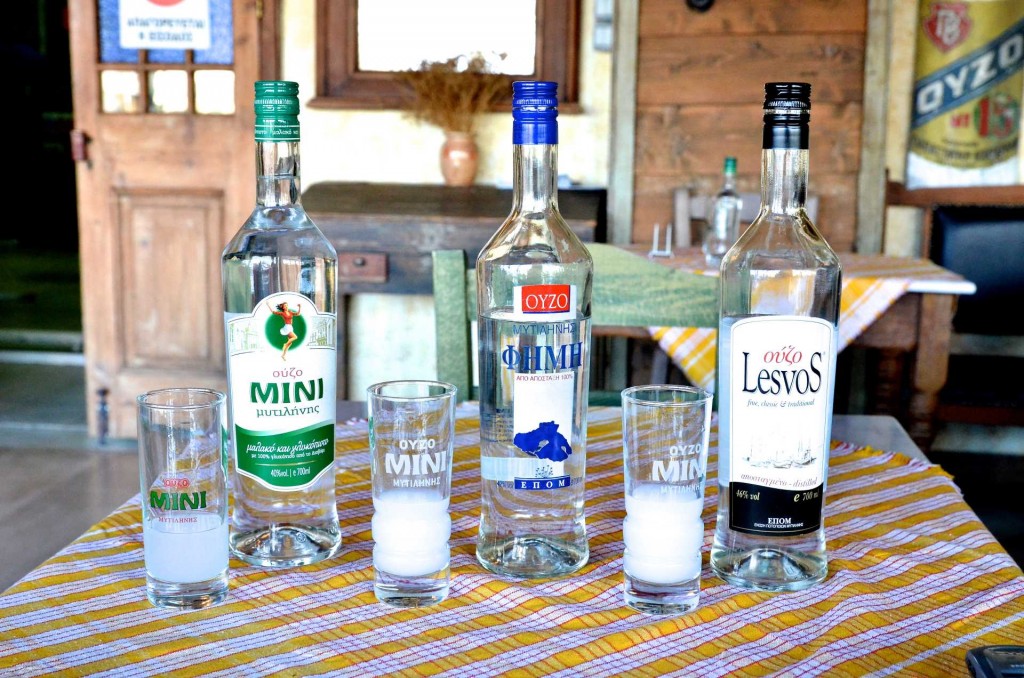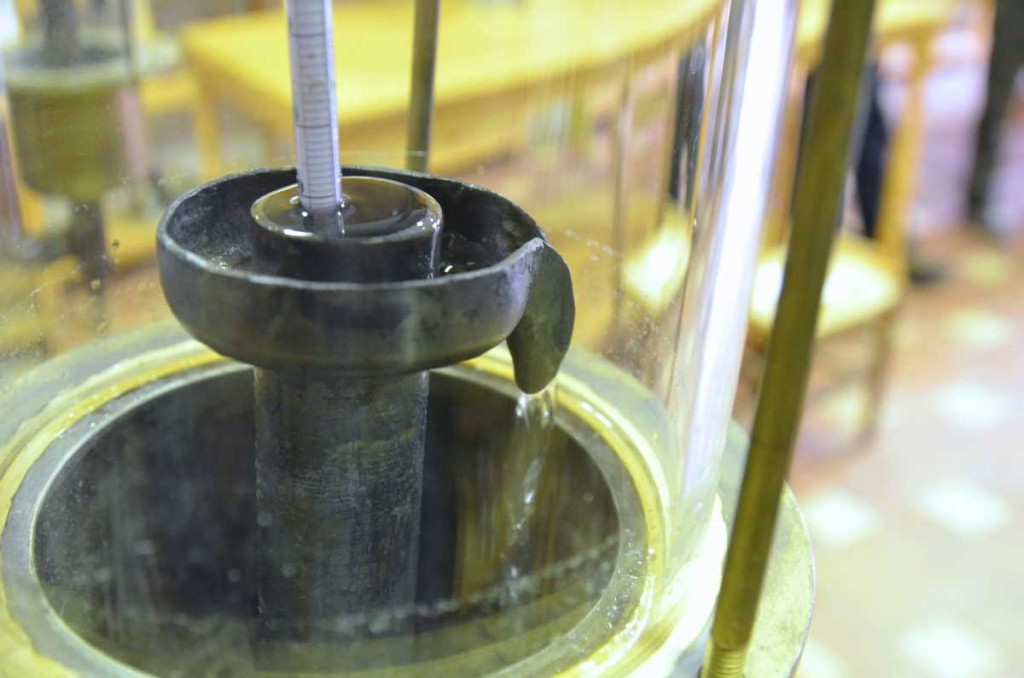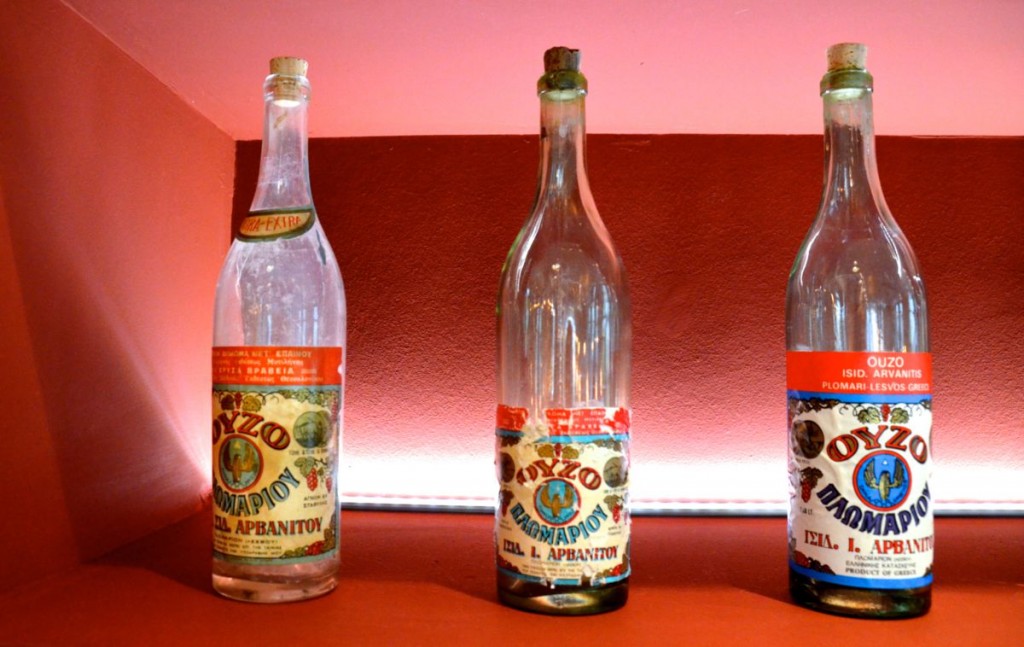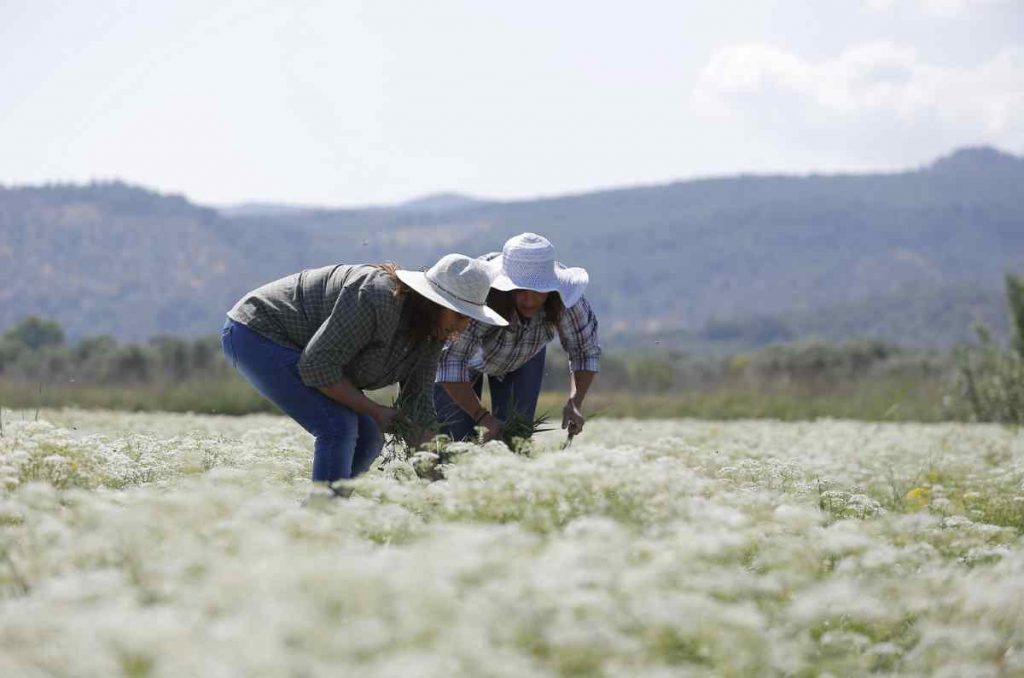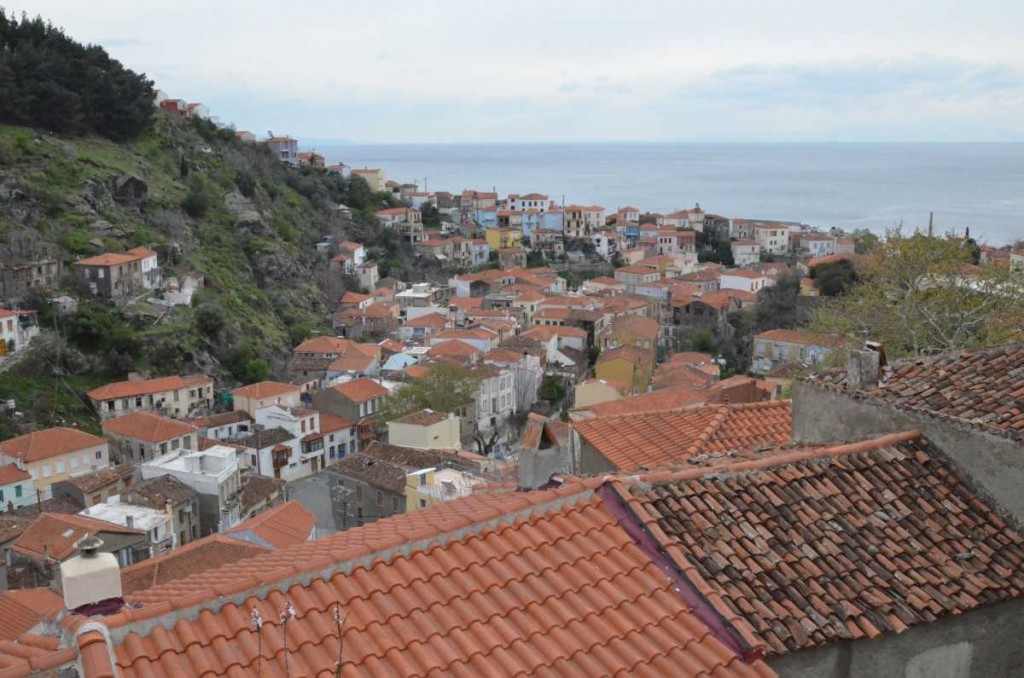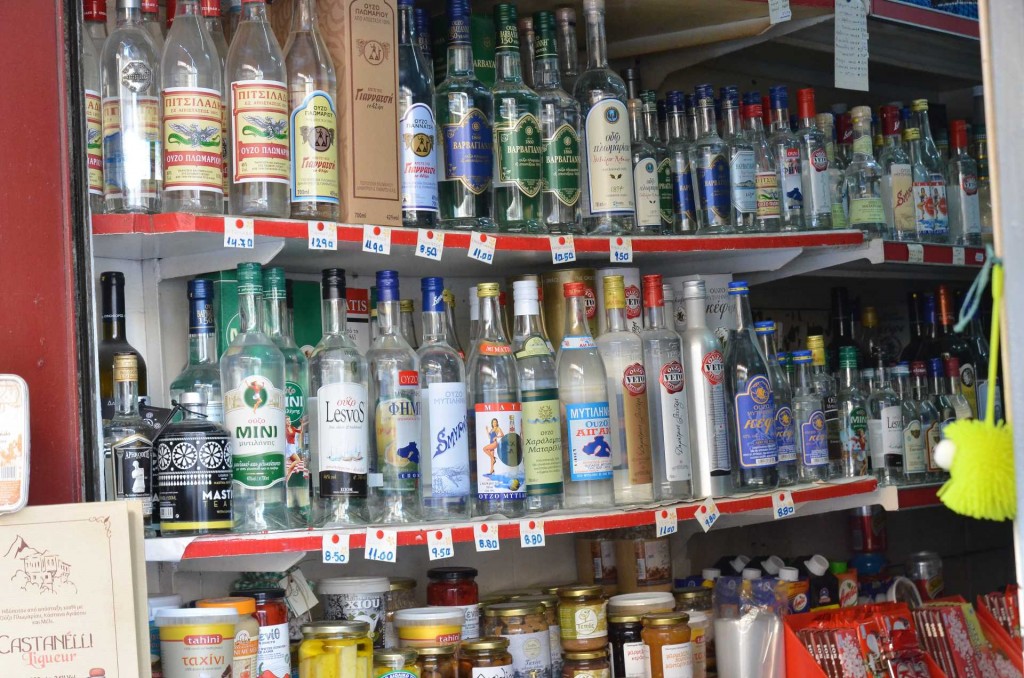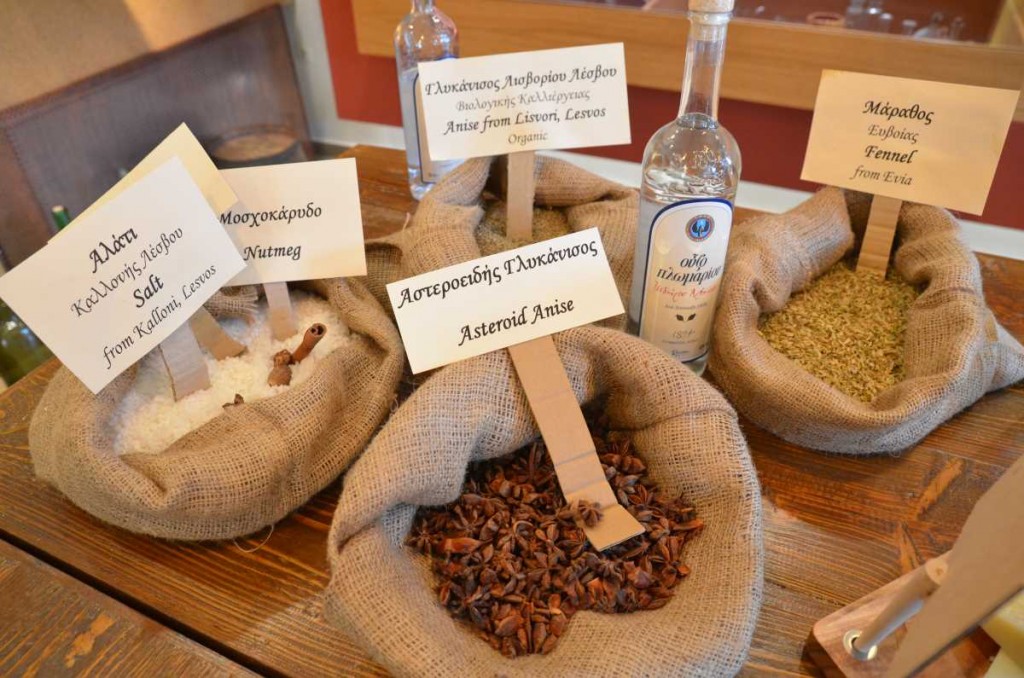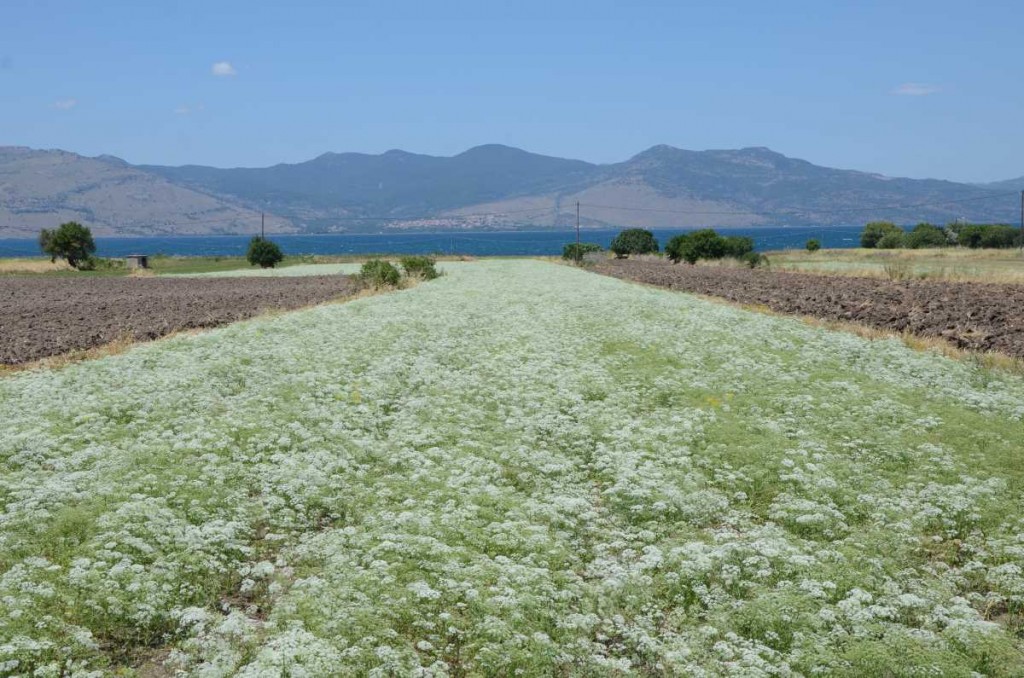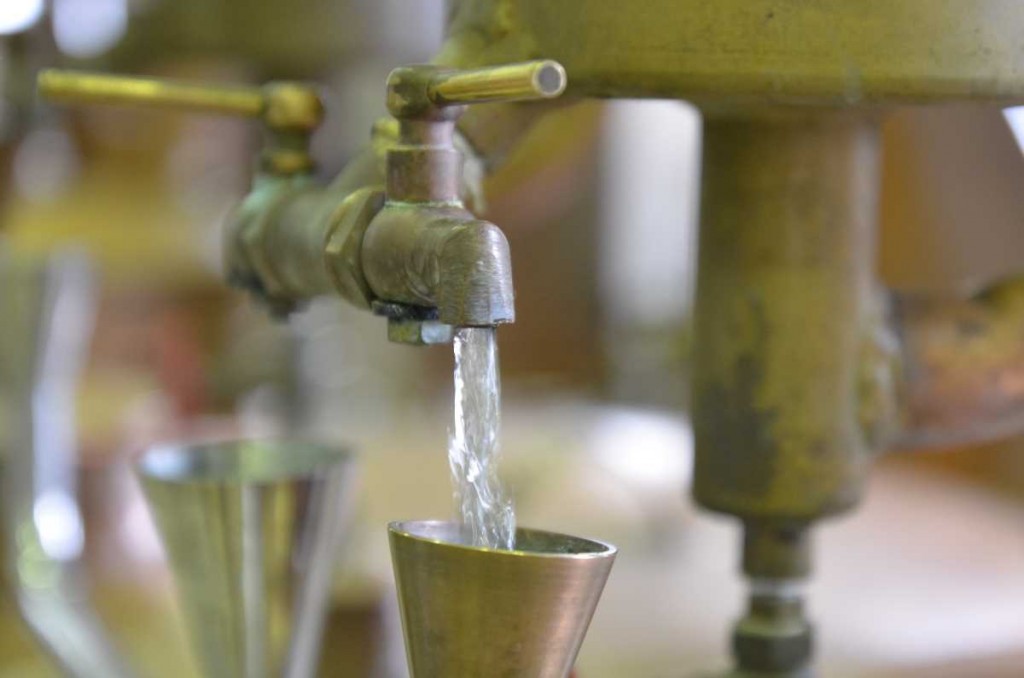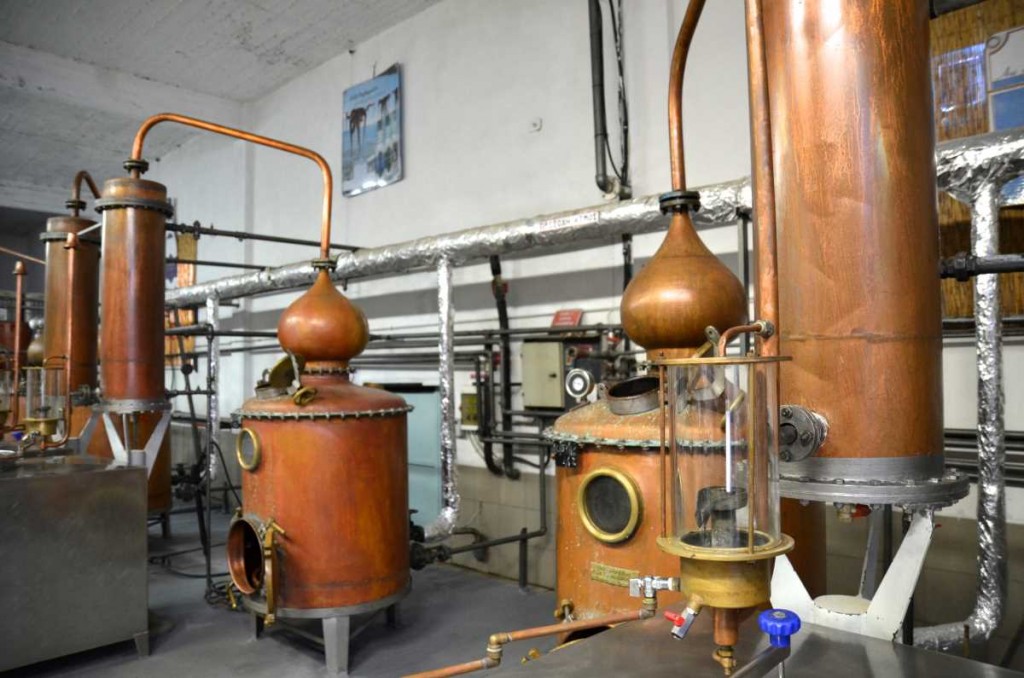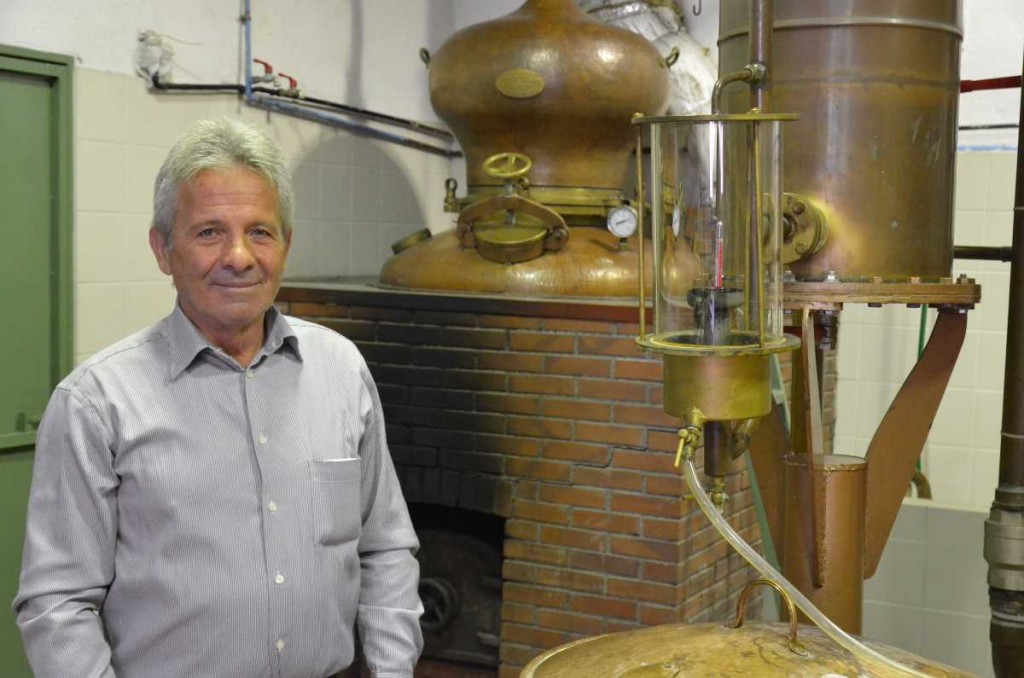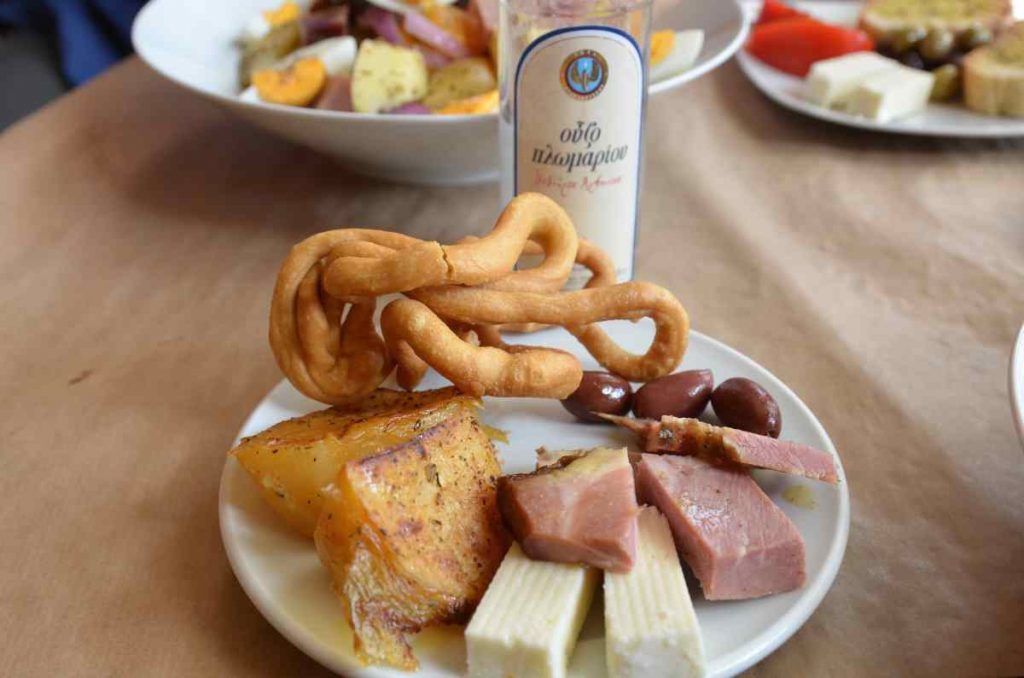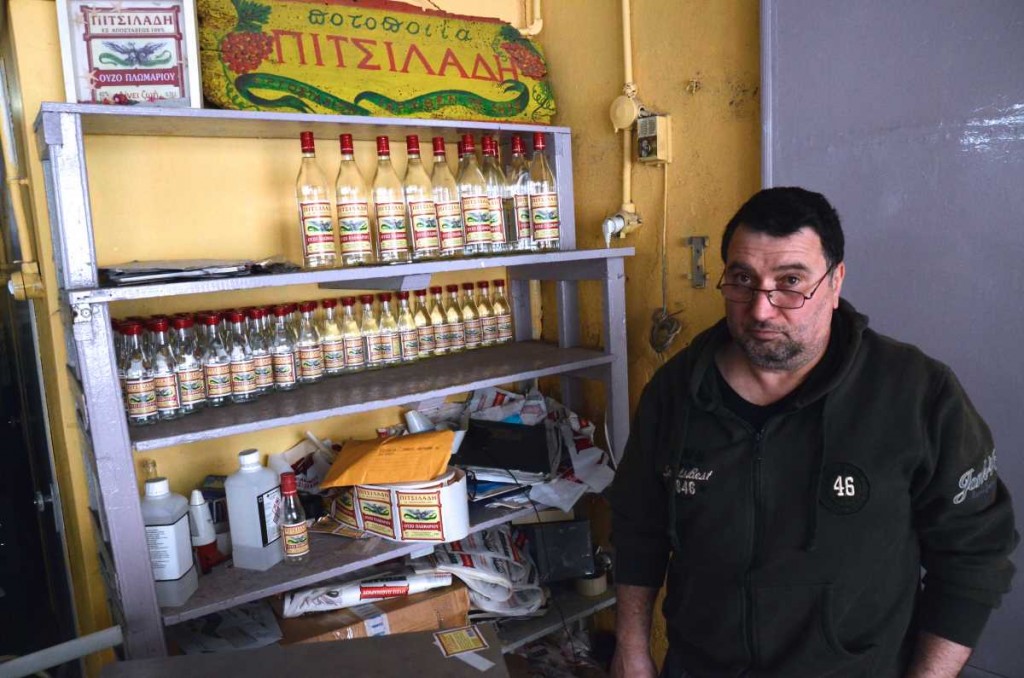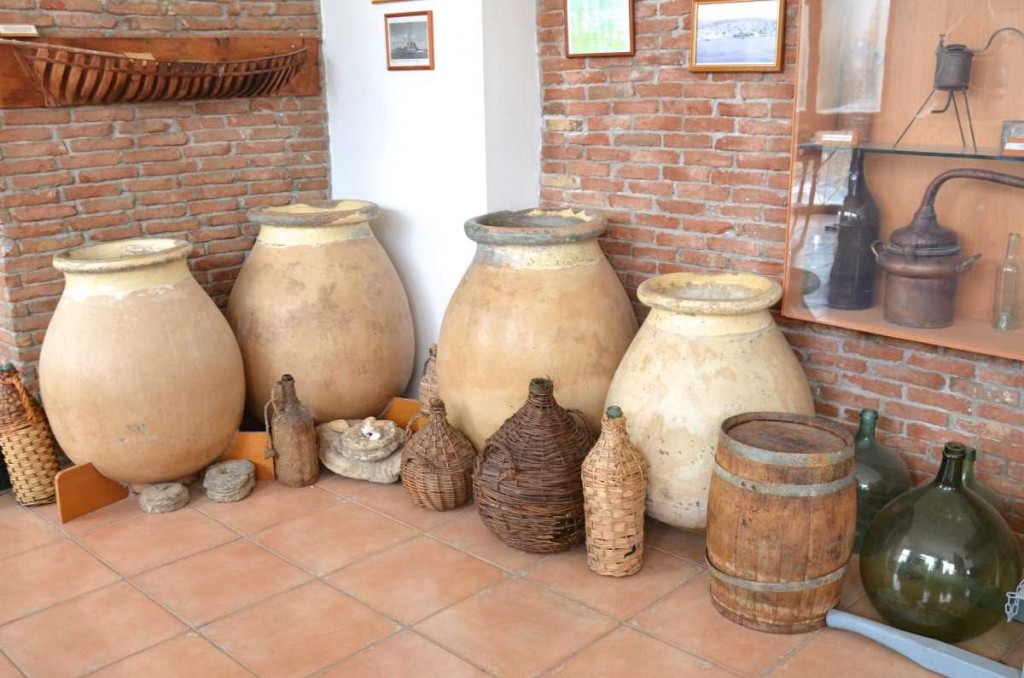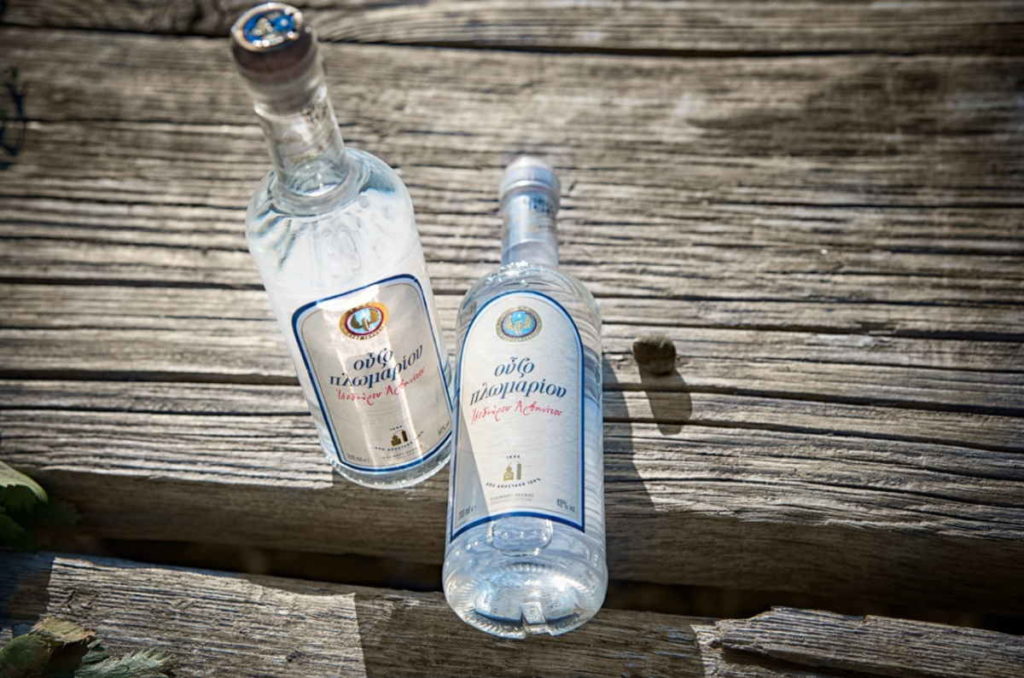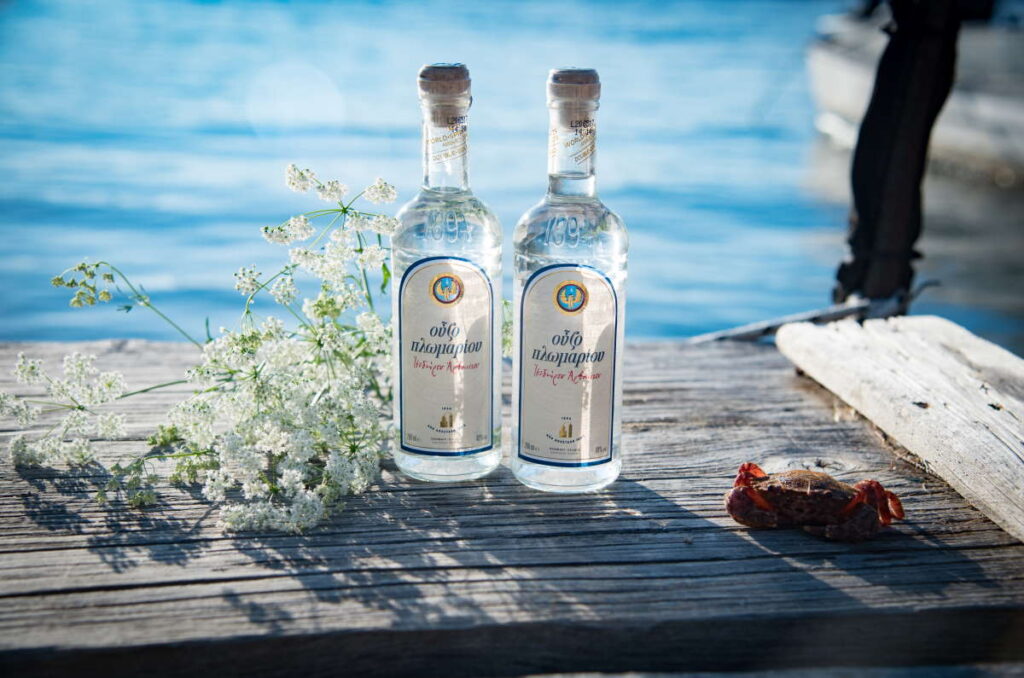Ouzo, the drink that expresses like no other the mentality, the temperament and the philosophy of the daily life of the Greek and therefore a part of his cultural identity.
Tribute of the Greek Gastronomy Guide to ouzo:
- Ouzo in general
- What is ouzo
- History of ouzo
- Places and areas
- Organoleptic data
- Ways of ouzo production
- Tasting - How to drink ouzo
- Map with ouzo appetizers from all over Greece
- Ouzo and its appetizers
- Ouzo in Greek customs
- Ouzo in Greek song
- Interview with Mr. Nikos Kalogiannis, president of Plomari distillery Isidoros Arvanitis
Ouzo in general
There are products that contribute to the economy and the identity of a place, but none has been identified as much with the culture of the Greek people as ouzo. The national drink of Greece walked, arrived and fixed well in our culture, accompanied us in our loneliness, thrived in our company and took off our companies, playfully balancing between National and international, the popular and cosmopolitan, the local and ecumenical. The "glass" with the ouzo was identified with the summer, the sea, the sun, the meze, the relaxation, the company, the good mood and the cheerfulness and of course it delivers lessons of Greek diplomacy traveling the world with its white color on the blue of the Aegean sea.
And it is no coincidence that dozens of songs have been written about it, with the following characteristic that describes more than any other the feelings that one can feel after an ouzo drink:
"Ouzo when you drink / become straight
king dictator, / God and cosmopolitan.
As you mold / find it you will rejoice
and you want to see everything in the world / pink ".
What is ouzo
The Ouzo is a product of the Greek Earth that comes from the distillation of agricultural raw materials such as cereals, molasses, etc. in the presence of anise. Strange drinks are found in the Mediterranean countries due to the special climatic and geological conditions: in France in Pastis, in Italy the Shampoo, in Bulgaria the Mastic, in Turkey the Raki, in the Arab countries the Arak.
Ouzo, however, is superior to other non-alcoholic beverages in the Mediterranean for 2 reasons:
- Due to the production process, that is, that it is a product that comes from distillation giving character to the impersonal raw material, which is the distillate of agriculture in fact, and distillation itself is an art for many.
- The herbs and fruits of the Greek Earth, dominated by anise, give the elegant taste to ouzo making it unique.
And if the multifaceted, well-traveled and imaginative Greek soul imposes the need for extroversion, nostos, and passion made ouzo internationally known, transcending national geographical boundaries. Germany, Australia, Turkey are just some of the countries that taste Greece in their glass.
Protected by the European Union with the indication PGI (Protected Geographical Indication) ouzo is produced exclusively in Greece and is the only one that has been registered as distilled anise (distilled anise). Also, some areas have been recognized as protected geographical indications due to their long history and tradition in ouzo production, such as "Ouzo PlomariouWhich is also considered the homeland of ouzo. In fact, for the areas that are PGI, the distillation and bottling of ouzo must be done in the area, ie in Plomari, the "Ouzo Plomariou".
History of ouzo
If wine, the product of the magical fermentation of grape juice, is the gift of Dionysus to humanity, ouzo is the essence of spiritual vitality and ingenious folk wisdom, charged with the ingenuity of ordinary people.
Thanks to the passion and concern of traditional societies to utilize the remnants of production and food - a long tradition of peoples making "diamonds" from "garbage" as happened with food - with the great example of Italian pizza, the Spanish paella - but also the constant effort of the most enlightened of them to deal with alchemy, the process of "dissolution and reconstitution", the distillation was created, and with the distillation of the grape marc we were gradually led to the discovery of the favorite drink of the Greek .
Its beginnings prehistory of ouzo are identified with the history of primary distillation. It is speculated that a drink was produced in a similar form from antiquity and is still lost in the depths of history, with the first signs of distillation in Crete, in 500 BC. and with a working hypothesis that the amblyas, the vessel of distillation, to be a Greek invention. What is certain, however, is that it was already known during the period of the Byzantine Empire. During the Ottoman period, spirits were widespread in the regions of the Ottoman Empire, but also in areas of the Middle East.
There is not much evidence here but what is certain is that throughout the Mediterranean there are drinks with anise, because anise is a plant that gives a very nice special aroma, wants sun, sea and grows in the Mediterranean. So the whole of the Mediterranean and Greece, which was then under the Ottoman Empire, but also Turkey, began to experiment with intoxicating drinks.
The modern history of spirits begins in the era of Ottoman rule, and this is because the Prophet Muhammad did not intend to ban wine and spirits. Starting from Mount Athos, the spirits conquer the whole Ottoman Empire, with the most important distillation centers being Istanbul, Izmir, Alexandria, Tyrnavos, Plomari and Crete.
And we come to the time of the 19th century where for the first time agricultural alcohols were discovered and spread and used instead of being produced from the beginning in distillation. In this phase ouzo - which was originally raki - is released from the primary distillation and the noble alcohols are enriched with aromatic fruits and herbs, such as anise, mastic and various herbs that give the distillate a more delicate, aromatic and refined dimension. In essence, we are talking about a quality upgrade and a "domesticated" and "refined" version of raki.
At Lesvos, and specifically in Plomari, there is a long tradition in ouzo production since it started to be produced in the middle of 19th century by Greek families familiar with the construction of copper abysses, who fled from the coasts of Asia Minor, transferring experience and Peraki for distillation. Today, ouzo continues to be distilled exclusively in Greece based on anise seeds. Specifically, as a base, distillate is used from agricultural raw material and most often from cereals, which is placed in copper cauldrons and takes the aromatic character of the recipe of each distiller through the process of distillation, from herbs and fruits, dominated by anise, which gives it this characteristic taste.
As far as the history of the ouzo name is concerned, the origin of its name is not known with absolute certainty. Various views have been expressed on the origin of the word ouzo. These views could be said to be more folkloric in nature.
There are three versions of the ouzo name. According to the first, the name comes from the phrase "uso di Massalia", meaning to use Marseilles with which it had trade relations. The second version states that it comes from the ancient Greek verb ozo (that is, I smell), while the third and less probable, that it comes from the phrase "I live" (I do not live without ouzo).
According to the first version, which seems to be the most prevalent, the word ouzo comes from the Italian expression "Uso di Massalia" which means "for use in Marseille". Marseille, as mentioned above, was one of the first places we exported silk. The boxes "Uso di Massalia" were written on the boxes sent to Marseilles to show where they were going. So once upon a time a pasha who drank anise spirit was said to have liked it so much that he said, "But this is Uso di Massalia!", Meaning that it is as good as the products sent to Marseille. And so it is said that ouzo got its name.
As for the less prevalent version (ou live) it comes from the Greek novelist Nikos Gabriel Pentzikis (1908-1993), who claimed that the word ouzo etymologically comes from the phrase "I live", giving the drink a transcendental dimension and horizon it as an expression of the state of mind that leads beyond life and death.
Places and areas of ouzo
If the Aeolian Land of Anise is the homeland of ouzo, then undoubtedly the Plomari considered the capital. In the bronze abysses of Plomari the tradition and the historical memory of the place are distilled in the same way from the 19thο century.
The persistent, well-traveled, anxious and cosmopolitan Plomari, who were a wealthy class of sailors and merchants, who knew how to enjoy the joys of life, the strategically unique geographical position of Plomari and the trading port between Europe and Asia, allowed the locals to make ouzo of excellent quality. Special mention should be made of the fact that the phrase Ouzo Plomariou, is also a Protected Geographical Indication, certifying the excellent quality ouzo produced in the area and following special technical specifications.
Today, ouzo is produced throughout Greece as ouzo producers are over 300. This results in a significant differentiation of products in taste and quality, as the raw materials are one of the ingredients that differentiate ouzo and they distinguish it. But champions in quantity, quality and reputation are ouza of Lesvos, where 17 distilleries produce excellent ouza, covering it 50% of Greek production, while in the rest of Greece the areas that produce ouzo in addition to other drinks are its areas Tyrnavos, Chios, Macedonia, Achaia and Epirus.
The first branded ouzas in sales are estimated at 5, with number one in "Ouzo Plomariou Isidorou Arvanitou"And then the well-known names"Ouzo Varvagianni","Ouzo 12","Ouzo MINI Mytilene», and "Ouzo Tsantali».
Organoleptic characteristics
The Mediterranean area is rich in plants and aromas. Thus, the anise "Pimpinella anisum", the fennel "Foeniculum vulgare miller", the asteroid anise, the mastic, the cinnamon, the clove, the coriander, the angelica root, the linden, the cardamom (kakoules). a. entered the abyss to refine the distillate. Ouzo, as mentioned, is classified in the category of anis, ie alcoholic beverages with anise aroma and in fact it is only registered in the European Union as distilled inequality (distilled anise).
Although there are no scientific studies on the action of white spirits, experts estimate that, as alcoholic beverages, in small doses (1-2 glasses) ouzo and tsipouro provide health benefits.
Ouzo has a pleasant aroma, cools, cheers, "opens" the appetite thanks to the anethole, the essential oil of anise, which it contains. Anise, which gives ouzo its characteristic taste, is thought to help absorb iron from food. In addition, it soothes intestinal contractions, while it also has a mild antiparasitic effect on the intestine. Finally, ouzo causes vasodilation and lowers blood pressure.
How to produce ouzo
It is important that the distillate used as a base is neutral so that each distiller can give his own character to the recipe through distillation. Thus it is now used as a base, distillate of agricultural origin and more often from cereals, which gets its aromatic and taste characteristics through the distillation with anise and other fruits and herbs.
The production process, ie the distillation, in most distilleries is still traditional today. Thus, in traditional handmade copper abysses (cauldrons) boil for hours the alcohol, the seeds and the aromatic raw materials. The mixture is then distilled without abrupt changes in both heating and cooling. From the first distillation, the and "heart", the most delicious part of the distillate, which passes to the second or third phase of the process (redistillation), slowly, with continuous checks and tests.
Before the distillate reaches the bottles, it is diluted with soft water so that the final product acquires the desired alcoholic strength. The high alcohol content is a prerequisite for the incorporation of the rich aroma of ouzo. In fact, according to the legislation, the alcohol content must be greater than 37,5% vol.
In order for the final transparent distillate to reach us with the attractive packaging, a complex and detailed process is followed, which is often handed down as a testament from generation to generation and keeps the family secrets. Its success depends primarily on the size, type and material of the abyss. Alcohol as well as the various species from the amazing variety of aromatic plants that will be added, ultimately determine its distillate, aroma and taste.
Every distiller has his own secret. That is, the type and proportion of aromatic seeds it uses. It also differs in terms of the distillation fractions it will use, the extraction before distillation, the distillation rate, the size of the cauldron.
As we mentioned, ouzo differs from producer to producer. So good ouzo has several parameters of success, the most basic of which are:
- The recipe: Each ouzo has its own unique recipe that indicates which and in what amount of herbs and fruits will be used in the distillation or how many times the distillate will pass through the cauldron. A proper recipe ensures a balanced aromatic character and a nice tasty result in ouzo.
- The ingredients: Excellent quality of ingredients is essential if we want to achieve an excellent result. Of particular importance are the water used, but also anise, the main aromatic ingredient of ouzo.
- The art and mastery of the distiller: The taste, knowledge, long tradition and ability of the distiller play a very important role in the quality of the distillate.
- Distillation, by traditional method: According to legislation for the production of ouzo, at least 20% of the alcohol is required to go through the distillation process, in order to be flavored with the herbs and fruits of the recipe. Some producers choose to make ouzo 100% by distillation. In this way they achieve better refining, as all the alcohol of agricultural origin goes through the distillation process, thus creating ouzo with a more harmonious character and soft texture. Also, the traditional distillation method in handmade copper abysses, is the only appropriate production method that gives the distillate its special character.
- Checks, at all stages of the production process to ensure quality.
From the above we see that a lot of style and temperaments emerge: ouza soft or firm, sweet or peppery, light or rich, aniseed or floral and so on. An endless wealth of flavors - to make the enjoyment last as long as possible!
Tasting - How to drink ouzo
Ouzo is usually accompanied by appetizers, such as salted, spicy, sour. Serve in small or thin and tall glasses and adding cool water and / or ice. Modern recipes want ouzo to be used even in cocktail making as an imaginative and delicate way of combining tradition.
Ouzo has specific stages of tasting. Visually, ouzo should be clean, crystalline and clear, as these are elements that show its quality. When we bring it close to the nose, the smell should be clean, with strong aromas of anise, while the other fruits that have been used such as fennel, mint, the aroma of mastic and eucalyptus should be distinguished. In taste, as soon as we try even one sip, it should have a semi-sweet taste, balanced with a full body and a long aftertaste, which to achieve requires a good recipe and art from the distiller.
As mentioned before, we dilute ouzo with water, but here it needs special attention as it is a process that can change the taste of the final distillate! Be careful, ouzo is never stored in the refrigerator, we only add ice cubes.
The right way to serve wants to serve ouzo first in the glass, then water and finally ice to gradually cool the distillate, releasing all of its aromas.. Adding water, ouzo turned white! The emulsion is characteristic of ouzo and comes from the essential oils of anise. With water, the temperature of the distillate drops, its alcoholic degree decreases and the oils that were previously dissolved and hidden in the distillate "appear".
Heavy milking, as is often misunderstood, is not a sign of superior quality because it means that aromatically and tastefully we have a one-dimensional product that smells like ouzo, but does not have its own character and specificity.
Map with ouzo appetizers from all over Greece
Click on the ouzo bottles from Plomari on the map and discover ouzo delicacies from all over Greece!
Ouzo and its appetizers
Ouzo accompanies intense flavors, ie savory, spicy, sour dishes, with fine local products and top seafood. The meze is usually served on a small plate, because it is not for "satiety", but to accompany the drink, so that no one drinks it "xerosfyri". The toothpick is a common choice to facilitate gripping and attaching the sliced bread - antidote-shaped - to the seated appetizer, but small forks are also acceptable.
Ouzo is an aperitif, and is drunk with friends, to "open" the appetite, before eating, usually from 12 and after noon. Thanks to the essential oils of the anise and fennel seeds it contains, it gives the palate a taste of spring breeze and sunny sea, while creating a pleasant feeling of coolness able to soothe even the hottest Greek summer. The anethole - the essential oil of anise - it contains, is considered to have an "appetizing" action, aided by good company.
In the course, however, with the evolution and multiplication of appetizers, but also with the willingness not to interrupt the company, it also evolved into a way out for appetizers that replace food.
Typically, however, the way one drinks ouza differs from the way one sits in the restaurant. The process is essentially a ritual. The body is on the side and not perpendicular to the table and the seat in the chair is lazy.
We distinguish their appetizers by sea and on land, and we may have combined ouzo with sea, sun and the corresponding appetizers, perhaps due to its island origin and its whitish color, but those who tried it found that it also matches its appetizers. land. So ouzo goes well with:
Meats, salads, grilled fish, aged cheeses, smoked cheeses, feta cheese
Salamakia, apaki, smoked, siglino, pastourmades, soutzoukia.
It also goes well with pans and all kinds of fried meatballs (meat, tomato meatballs, fennel meatballs).
Fried squid κια fish… marida, atherina, shrimp, grilled octopus.
Potatoes, croquettes, saganaki.
Olives, dolmadas with lemon, pickles and pickles…
Raw shells (starvation, mussels, quinces, oysters, purples, horseshoes, tubes), roe, caviar.
All kinds of pastes, sardines, curds, lakerda (fatty).
Gastronomically, ouzo, apart from being a delicious combination with appetizers, is also an ingredient in traditional recipes and mainly island (Lesbian) recipes, where it has always been in abundance.
Two classic lesbian recipes are:
Oh, yeah Aromatic meatballs with ouzo and cumin, where in the mixture with the minced meat, the bread together with the grated onion, the egg, the locals add cumin, oregano, and ouzo.
Oh, yeah shrimp with ouzo, where ouzo enters at the beginning of the sautéing and tying of the sauce, but also at the end just before the last cooking.
Ouzo in Greek customs
Ouzo as a purely Greek product, exists, as is logical in many customs of Greek tradition and culture. Thus we see that ouzo has a special place mainly in marriage and childbirth.
- In Thrace, ouzo has been combined with the institution of marriage. More specifically, before the engagement, the bride's father invites the groom to his house with a bottle of ouzo to meet. Also, in the past, the groom (the person who made the wedding invitation) would go from house to house with a bottle of ouzo, a glass of basil, and serve it to the family saying the invitation. They also drank ouzo on the wedding day at the groom's shaving ceremony. In addition, in Thrace, it was a very typical custom on "Baba's day" as the ancients called it, at the table held in honor of the mother-grandmother who helped in the birth, to dominate the appetizers and ouzo.
- Respectively in Thessaloniki and specifically in Asvestochori, the wedding ceremony contains ouzo at various times, both during the party, as a treat from the owners of the cafes where the wedding procession passed, and as a gift from his mother. groom to the bride's mother the day after the wedding.
- In Samos, it is customary at weddings to first offer donuts with ouzo and then to make the established celebration - a festival for the event. Also, at funerals they have the custom of sharing fluffy straws with ouzo.
- In the Peloponnese, New Year's kourabiedes are usually sprinkled with ouzo instead of flower water.
- The custom-medicine is also of unknown origin, where if the child suffered from jaundice after birth, the mother would visit him, put ashes with ouzo on his back and with a razor he would shave it lightly and so, supposedly, the jaundice would go away.
- Finally, a typical custom-practice throughout Greece, is to use ouzo in cases where a tooth hurts, to temporarily relieve us of this great pain!
Ouzo in Greek song
If poetry is the essence of life, ouzo the essence of romiosity is the most sung drink by the popular muse. It whets the appetite, accompanies nice appetizers, lifts the mood, boosts self-confidence, releases emotions, but also soothing against sadness, sadness and frustration inspired many lyricists who wrote many songs that praised ouzo.
"Ouzo when you drink / become straight
king dictator, / God and cosmopolitan.
As you mold / find it you will rejoice
and you want to see everything in the world / pink ".
(lyrics by Aim. Savvidis, with Ch. Alexiou)
Aaaa, for the ouzo mezedaki pastourma - pastourma,
saganaki meatballs with minced meat / vai - vai, carafe ouzo,
let us drink them now that we are having fun,
the dunia the liar once we live it.
(traditional)
All ouzo, ouzo, ouzo, I got bored
Bring me a cigarette that I wished for.
(The children of your neighborhood… Asia Minor- Marika Papagika)
Ouzo morphine and hashish aman-aman mild to forget
but I did not succeed in poverty, I am about to lose them.
(Peristeris Spyros- Rosa Eskenazy)
I swear to you, my Vangelis, let us tell you
in the backgammon we play, in the ouzo we will drink.
(The news of Alexandra - Costas Giannidis - Vangelis Perpiniadis)
Sweet Drapetsonitissa, I spent many nights
for this fluffy body of yours, I will drink plenty of ouzo
I will do the hard work too, for my little doll.
(Drapetsona- Stellakis Perpiniadis)
In Larissa the river called Pinios.
if you do not want me there I will fall to drown.
Bring ouzo from Tyrnavos to sit and drink
and all of Larissa to learn that I love you.
(The river in Larissa - George Mitsakis - Spyros Zagoraios)
Ouzo: the national drink with an international career - Interview with Mr. Nikos Kalogiannis, president of Plomari distillery Isidoros Arvanitis
Sweet and spirited, aromatic and fine, ouzo, a distillate inextricably linked to Greek tradition and island culture, is rightly considered the protagonist of Greek drinks. Born in the Greek soul, ouzo is one of the national products that has been making a successful career in Greece and abroad for years. Mr. Nikos Kalogiannis, who is at the helm of the Plomari Potopoiia Isidoros Arvanitis and president of SEAOP, explains the history and the success of the favorite distillate of the Greeks.
"The ouzo sector is a very dynamic and extroverted sector for the Greek economy that includes about 300 producers throughout Greece," says Mr. Kalogiannis. "According to the data of 2016, the volume of exports reached 45 million bottles (equivalent 700ml / 40% vol) and of these 30,07 million bottles (equivalent 700ml / 40% vol) relate to ouzo. 70% of the Greek production of alcoholics, are alcoholics with Protected Geographical Indication at EU level. "Also, the share of ouzo in exports reaches 69,32% of all Greek beverages that are exported, with Germany being in the first place in the consumption of ouzo with almost double performance in relation to the domestic market", points out Mr. Kalogiannis.
One problem of the industry, despite its excellent export performance, is the increase in taxation. With over-taxation, 60% - 65% of the retail price is estimated to be taxes. The president of SEAOP points out: "Despite the domestic success of ouzo, foreign markets are considered almost a one-way street for many companies in the industry, given that ouzo accounts for almost 70% of spirits exports."
The success story of Ouzo Plomari Isidoros Arvanitos
"We wanted to make an ouzo that worthily represents the way of life of the Greek and to travel around the world", says Mr. Kalogiannis and continues: and in about 1993 years we managed to ouzo Plomariou Isidorou Arvanitou, to become the leader in the ouzo market. Today, we have sales in 25 countries with exports accounting for 40% of our production. "
"The goal of the distillery", as Mr. notes. Kalogiannis, "ouzo was, from a popular drink for a few to become a drink for everyone, combining concepts that are at the same time opposite, such as interiority and opennessThe Greekness and internationalismThe popularity and cosmopolitanism. It is no coincidence that we married the old traditional recipe with the ultra-elegant embossed vials with the cork stopper - which unconsciously referred to the champagne stopper - to create the feeling of a package containing a valuable content of 100% double distilled traditionally produced care and passion ".
With the competitive advantage of the exceptional quality, accompanied by the legend of a brilliant history, the Ouzo of Plomari Isidoros Arvanitos wins the foreign markets with the supplies of the international and domestic awards.

